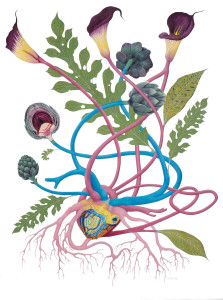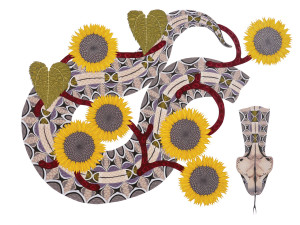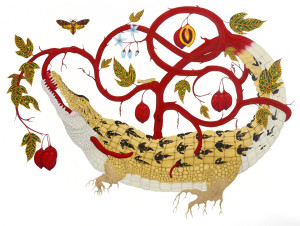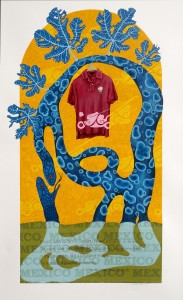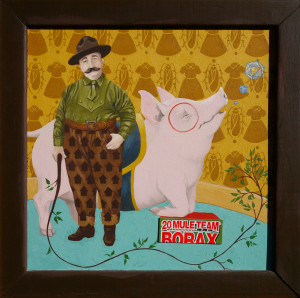IT IS A RARE mild September afternoon in Dallas when Kim Alexander sits me down. We are at her kitchen table, mere yards from her studio, which has spilled out of one spare bedroom into that familiar mid-mod home space, the den. In the regional vernacular for which we Texans are known but which we hardly ever use, this sitting down has been a long time coming. Not that Kim is going to lecture me; that’s not the nature of our relationship. Still, I am here to learn. I have volunteered to be a pupil for the day, though not one of her students. The distinction is fine, but as this story will, I hope, reveal, it is a crucial one. I am here to suspend what I think I know; to record something of what I see and hear; and above all, to listen to what she tells me are “some of [her] anxieties.”
To look at her paintings, one might marvel. How can there be any source of anxiety here? That is, how could an artist be apprehensive about images so technically accomplished, so vibrant and yet so subtle. Nevertheless, there is a deceptive legibility to her work that could absolutely be a source of anxiety. Is this what she is thinking? That we might misconstrue the proficiency displayed here as a self-congratulatory mastery, and forget that what we think of as skill is really the outgrowth of a deep affection for and unselfish engagement with the materials of one’s art?
None of this is what she means.
Instead, she tells me, “I have a perfect story arc for those who want to advertise for a certain set of beliefs.”
Kim has noticed a tendency in some viewers to ascribe a sort of saintliness to her work, and to superimpose a potentially marketable narrative of grace and salvation. As I listen, I begin to feel a little anxious myself. How to repeat this narrative without furthering its circulation? For what any viewer of Kim Alexander’s paintings must understand is that narrative is at the heart of her practice. More accurately, narrative is that heart; narrative is both that practice’s literal nexus and the figurative seat of the sympathetic understanding it seeks to sustain.
Take, for example, Self-Portrait as a Teacher, one of the relatively large paintings (it measures 40 by 30 inches) in which Kim has been absorbed over the past several years [see Plate 1]. It is part of a larger sequence, the Young Immigrants series. Despite the title, you will look in vain for any apparent portrayal of the painter herself, much less any figure who could be categorized as recognizably “immigrant.” What you see instead is a tangle of veins and arteries, stemming and blossoming from a heart that floats in a white void. These stalks terminate in black-lipped lilies, dark, broad leaves, and what appear to be artichokes. The image feels impossibly coherent: the heart is rendered with anatomical correctness, but the artichokes and lilies show themselves to us both whole and in cross-section. The image occupies two separate planes simultaneously, and the object of our scrutiny, neither wholly flora nor fauna, has had its interior as well as its exterior exposed to us.
Spatial relations that were bewildering a moment ago resolve as Kim reminds me that, in the tradition of scientific illustration, there is nothing strange about an image whose strategy of display renders a single specimen from a variety of perspectives. Yes, this is a “painting” in an empirical sense: a picture made with pigments combined with filler and incorporated into a binding agent, then applied with brushes to a flat surface. And the picture thus formed does make some reference to the reality most apparent to the human eye. But this self-portrait is not a painting in the sense that it tells its story in the same way other paintings do. To make sense of the story here, you have to approach from a different posture. In fact, you have to step outside of typical art idioms altogether.
Imagine: a teacher observes her students. She must preserve a certain objectivity, an assessing free of judgment, in order to help them complete the hard work required by their own education. And how much harder that work is when the students are new to this country. They are encountering a culture in which the teacher herself was born, but in which she has never felt perfectly at home. Like a scientist, she encounters new and wondrous phenomena in the course of her observations. She hears stories of prior lives. She hears stories of hardship and violence, of foolish romance and ignorant conflict (not just bullying, being pushed around on the bus or in the halls, but of conflict rooted in prejudices that run so deep they are taken for values), of internecine histories, of families ripped apart and families improvised out of individuals whom circumstances have made neighbors, people caring for people they barely know or have a right to care for, but doing it as best they can. The particulars of each story are important, of course, but less so to the observer than to the actors within those stories, her students. The teacher’s own story is the story of being opened up and changed by theirs. As all teachers know, you learn from your students as much as they learn from you.
Kim, of course, is the teacher; for the last decade, she has taught ESL to a highly diverse population of immigrant students at a high school in a northern suburb of Dallas. The school is located near a United Nations intake center, through which refugees are resettled. Although no formal relationship exists between Kim’s school and the UN, her classroom has been a temporary home to students from over forty different countries. And this is a conservative estimate. “I’ve had days when I’ve heard thirty different languages in my classroom,” she says. “And every major religion is represented. Every year, I get to work with nearly 130 students: undocumented kids, kids with their own kids, kids looking for opportunities, kids fleeing armed conflict. Every time there’s violence abroad, people from that location appear in my classroom…at least, those that can get away. The diversity is real, it’s global, and it can be overwhelming.”
She tells me that Self-Portrait is a portrait that portrays itself. It portrays her own contending with how to convey to the rest of us (the relative few of the privileged world) that very real things do in fact exist in worlds beyond our notice. The painting cannot completely abandon rational discourse, nor would it want to. Old and new, strange and familiar, “natural” and “unnatural” all participate in a distinct ecology here.
Kim points out that the flowers are calla lilies, indigenous to Africa, like many of her students. The artichoke is native to the entire Mediterranean, but was most extensively cultivated during the medieval era by Arabic-speaking peoples. Extrapolating from this pattern, the heart might be thought to represent the teacher herself. But that self should not be understood as a harmonizing force, or the source of an empathy that can resolve all of the strife that pulses throughout this image.
What this painting reminds us is that that self is a figure, a form, and as much a representation as this painting. In order to tell the story of Self-Portrait as a Teacher at all, the painter must acknowledge her position fully, including the prejudice, blindness, desire, and fear that inform that position. What this painting succeeds so well at doing is respecting the tension of “vibration,” as she describes it, in which the telling selves and listening selves, subjects and viewers alike, are all suspended. One might interpret the unresolved contest between the flat and the trompe l’oeil as a visual analog for that vibration.
I am beginning to understand what she means by anxieties.
“I have a reverence for my students,” she says. “The entire time I am painting, I am asking myself, ‘Why am I doing this?’ I’m not telling their stories for them because they can’t tell them for themselves. I’m not being good. I’m reenacting my own trauma, the trauma of being an orphan. My students outdo me in courage and kindness all the time. My students heal me. They’re my medicine.”
She shows me another work, which I call a canvas. Gently, Kim corrects me. Self-Portrait as a Teacher, Prison Fan, Garden, Oh, Africa, and Two Bullets are all works on paper. I step a bit closer. The entire surface is matte, even in its apparently blank areas. That is, these paintings are flat in another respect: they are not glossy. Kim works in acrylics, not oil. The body of the acrylics is more malleable, and more easily applied in thin, opaque layers than oils, which makes alterations easier. The acrylics also serve her purposes in that brushstrokes “take” less well. It is important to her that these paintings not reveal the hand of the painter.
There are practical reasons as well. As acrylics dry more quickly than oils, they permit her to work more confidently in discrete sections. She shares with me some photographs, taken on her phone, of a work in progress, Oh, Africa. The painting is dominated by the splayed-out skin of an African snake, its desert camouflage de-camouflaged against a white ground [see Plate 2]. The head has been separated from the body. American sunflowers appear to be sprouting up through the skin, as though this painting were lying at our feet, not hung at eye-level on a gallery wall. Everything we see—the spiral florets, the leaves, the snake’s protective coloring—possesses an almost hallucinatory exactness. But the painting, carefully plotted and sketched out in pencil beforehand, was assembled section by section. While working on a specific area (for example, the terminal twist of the snake’s tail), Kim would mask the other parts of the painting with sheets of carefully taped-up paper. This allowed her to affix her research materials—models, photos, botanical drawings—close to the working surface. This painting is the product of a significant amount of copying, she informs me. “I’m just repeating the same elements over and over until I’m finished. I’m more interested in the rhythm of those repetitions than in the painting being original according to someone else’s standards.”
I am less and less inclined to refer to these works as paintings. It feels more appropriate to consider them plates, or leaves, or perhaps broadsides. Except, these images are not part of a book. They have been separated from each other, and from the text they seem to be illustrating.
Kim tells me that her African students like to repeat the following maxim: Back home, when you kill a poisonous snake, make sure to cut off its head. Then, throw the headless body of the snake over the nearest tree branch. Otherwise, the snake will grow back together. Otherwise, the danger is not completely dispelled.
As a listener, what am I to make of this story? Am I to judge whether it is true? If I find it unscientific, am I to correct its misconceptions? I cycle through these questions, and I realize I am privileging myself, asserting my capacity to figure it out, at the expense of other possibilities.
Remember: “to experience” is synonymous with “to make oneself vulnerable.” Remember: it is okay to be dumbstruck. Kim has given me permission to be dumbstruck, by working out her own disconcertment and awe and susceptibility to excess in the painting itself. (“It’s okay to make stuff that nobody wants,” she says.) Remember: this painting is not a primary source. It is secondary, and completely honest about that fact. Remember: the artist is present in this image, not just as a conceptualizer or stylist, but as a witness herself.
In her classroom, virtually every day Kim hears stories in which the wisdom of tradition grapples with radically new contingencies. Oh, Africa is her vision of her students attempting to comfort themselves with the wisdom contained in their stories, only to realize that their wisdom is not as universally translatable as they would hope. She and her students have learned that, as she puts it, “the snake grows back together in America, in the form of violence against immigrants.”
I think again of the white negative spaces in these paintings, how they promise that the paintings will not be impenetrable. Their borders are not closed to us. They will permit us passage, provided we acknowledge that we are, at least temporarily, foreigners here.
I might add: the snake grows back together in the space between differing systems of thought, each convinced of its own truth—a space which is both a lamentable wasteland and necessary boundary.
Kim and I move on to Two Bullets [see Plate 3]. At first, the painting suggests that it can be read as two conjoined panels. In the upper half, a fantastical vine coils and sprouts variegated leaves, icy blue flowers, and fruits whose skins are a red verging on burgundy and whose pulp is an intense mango yellow. Across the lower half, a golden crocodile (a Nile crocodile, she informs me) flourishes in a great, grasping arc. This crocodile seizes a fruit in its jaws as a death’s head moth, its wings unfurled in frozen flight, keeps a safe distance.
Everything in this image is a hybrid of the actual and the imaginary. The fruits are based loosely on guavas, oblong, their seeds densely packed in a V-shape that also suggests the long swoop of a goat’s horns. But no guavas are colored like this. The flowers are likewise invented. Kim tells me that she wanted them to communicate the vitality of the plant. “That blue had to be there,” she adds.
Perhaps more than in her other paintings, color in its abstract or “pure” state is especially meaningful here. (Compare, for example, Garden [see front cover], which employs a similar symbolic vocabulary, but whose palette is both more subdued and naturalistic.) Two Bullets is a composition in, essentially, three colors: red, yellow, and black. These are the colors of the German flag; the great seventeenth-century German naturalist Maria Sibylla Merian provided a great deal of inspiration for this image. Beyond that association, however, the colors themselves are almost expressionistic. They are suggestive of emergency, menace, sickness, and death. Two Bullets depicts an organic impossibility. I would never call the painting surreal, however. Rather, Two Bullets exposes much that is mythic in our definitions of violence, most prominently, the myth that violence is always something exotic. Violence happens to someone else—not, heaven forbid, us. As Kim says, “There is a weird fertility to violence.” Violence feeds on itself, but it does not destroy or nullify itself. It conserves its resources. Violence is sudden and explosive, like a crocodile breaking the surface of the water to snap at its prey, or like a brutal attack by child soldiers upon a village in the middle of the night.
She mentions the relish with which some bully her students for being immigrants. We would like to pretend that violence, like certain people touched by violence, is plainly monstrous. In fact, violence is less alien than we’d like to believe. It can even present an attractive face. Two Bullets isn’t beautiful, I see, so much as it uses the rhetoric of beauty to make its own arguments against the conflation of the seductive and the acceptable.
This past-equinox afternoon is now waning, and it is apparent that I will manage only a partial survey of Kim’s work. I’ve not even mentioned a recent group of works on paper, part of the Young Immigrants series, that combine meticulously painted tableaux with stories from students’ lives. In these works, text—sometimes a student’s own words, sometimes Kim’s—is painted onto a small piece of paper, which is then glued to the painting. But first, Kim writes the student’s full name on the back, so that the name is hidden within the work. His Shirt Hangs There is a brilliantly colored example, a swirl of complementary hues at whose calm eye is a rather nondescript work shirt [see Plate 4]. It is a shirt worn by a student of hers in his role as the owner of a lawn-care business—a business he overcame many disadvantages to build. There is something votive about His Shirt Hangs There and, to be honest, all the pieces in this series. Their flatness feels more iconic than utilitarian, and the rounded arch at the pinnacle of each frame recalls cathedral window panels, or the alcoves in which the Stations of the Cross are set.
Boron is a fine example from this series. It stars the Paul Bunyan-esque “Borax Bill” and a Babe-esque hog [see Plate 5]. These humorous but deftly drawn characters lounge against a backdrop of cockroaches and frocks, borax being an essential ingredient of both certain detergents and insecticides. But has Babe gotten into Bill’s goods? Blue molecules seem to be bubbling out of the saddled pig’s mouth, and, with its front legs folded up underneath it, the creature certainly could be inebriated. Perhaps Bill’s serious mien and stout embodiment of the virtue of an honest day’s labor—even if that labor involves a fair amount of exploitation—are qualities best appreciated when subverted by animal extravagance. Why do we only come to see things are useful once they become useful to us? And how is it that what is at first merely useful so quickly becomes an addiction? Boron is a portrait of a familiar and all-too-human duality, presented with delightful wit and surprise.
Kim and I return to her kitchen table. We catch up. Our conversation turns from the business at hand and meanders into friendly complaint about the little predicaments and exasperations of creative pursuits. I forget my notes, or they fall away. But I don’t forget where we began, in her anxieties. “I don’t want to feed a cheap or lazy compassion,” she has told me. But she has also said that, for her paintings to be satisfactory to her, they have “to love, because love is always a gain.”
I have my own anxieties, of course. They advance in strength as I ready myself to depart, and as I consider the problem of having to arrange my notes into a cogent essay. I’m fearful of imputing meaning that is of little importance to the paintings themselves. I’m mindful of whose trusts I must keep. Am I adequate to the task?
Kim asks me if I have any ideas about how I might frame the essay I am about to write.
“I think I will tell it as a story,” I say.




